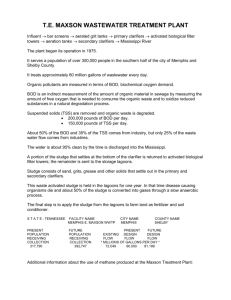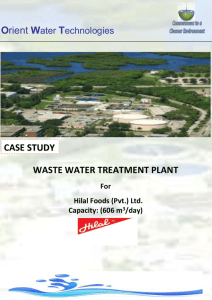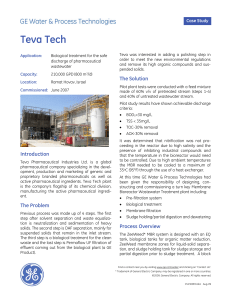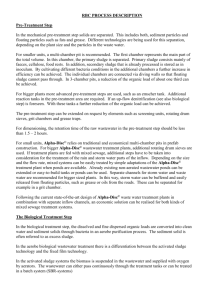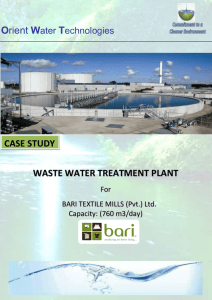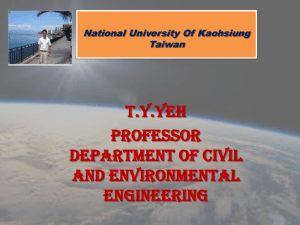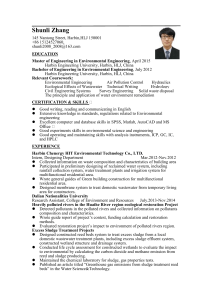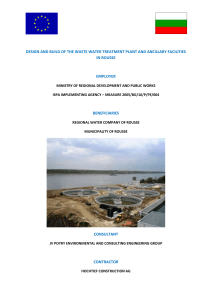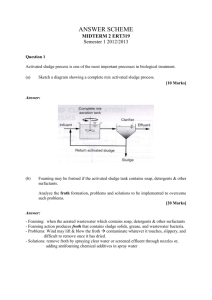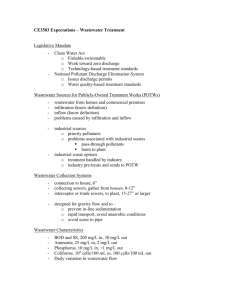Project Name: Potato Processing Wastewater Treatment
advertisement
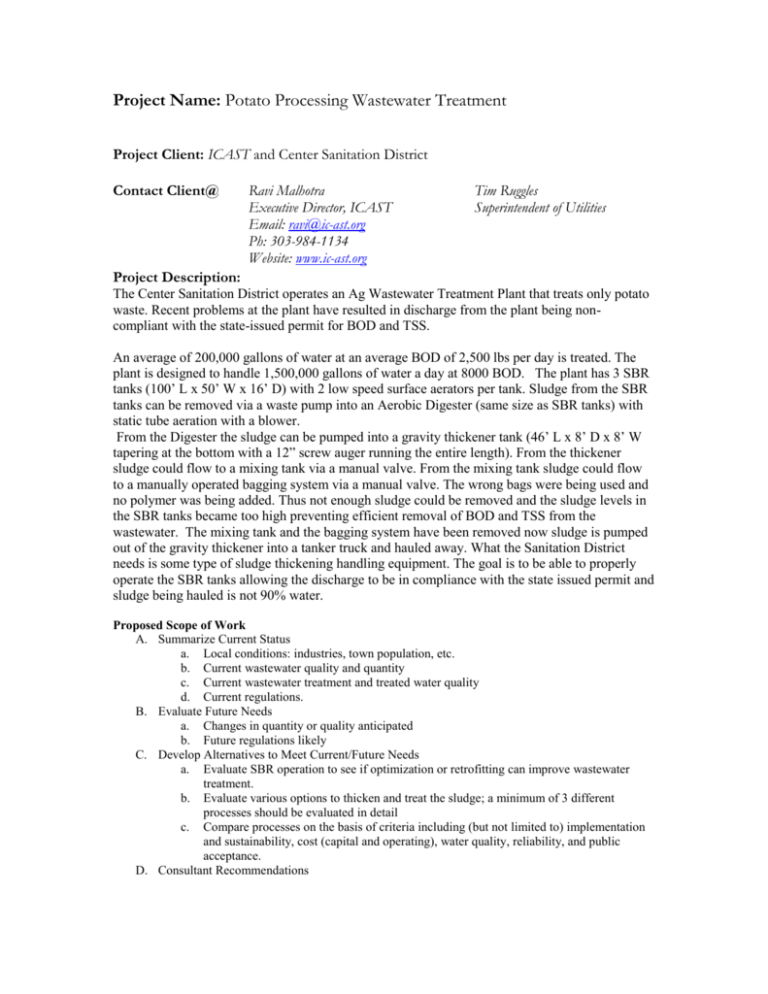
Project Name: Potato Processing Wastewater Treatment Project Client: ICAST and Center Sanitation District Contact Client@ Ravi Malhotra Executive Director, ICAST Email: ravi@ic-ast.org Ph: 303-984-1134 Website: www.ic-ast.org Tim Ruggles Superintendent of Utilities Project Description: The Center Sanitation District operates an Ag Wastewater Treatment Plant that treats only potato waste. Recent problems at the plant have resulted in discharge from the plant being noncompliant with the state-issued permit for BOD and TSS. An average of 200,000 gallons of water at an average BOD of 2,500 lbs per day is treated. The plant is designed to handle 1,500,000 gallons of water a day at 8000 BOD. The plant has 3 SBR tanks (100’ L x 50’ W x 16’ D) with 2 low speed surface aerators per tank. Sludge from the SBR tanks can be removed via a waste pump into an Aerobic Digester (same size as SBR tanks) with static tube aeration with a blower. From the Digester the sludge can be pumped into a gravity thickener tank (46’ L x 8’ D x 8’ W tapering at the bottom with a 12” screw auger running the entire length). From the thickener sludge could flow to a mixing tank via a manual valve. From the mixing tank sludge could flow to a manually operated bagging system via a manual valve. The wrong bags were being used and no polymer was being added. Thus not enough sludge could be removed and the sludge levels in the SBR tanks became too high preventing efficient removal of BOD and TSS from the wastewater. The mixing tank and the bagging system have been removed now sludge is pumped out of the gravity thickener into a tanker truck and hauled away. What the Sanitation District needs is some type of sludge thickening handling equipment. The goal is to be able to properly operate the SBR tanks allowing the discharge to be in compliance with the state issued permit and sludge being hauled is not 90% water. Proposed Scope of Work A. Summarize Current Status a. Local conditions: industries, town population, etc. b. Current wastewater quality and quantity c. Current wastewater treatment and treated water quality d. Current regulations. B. Evaluate Future Needs a. Changes in quantity or quality anticipated b. Future regulations likely C. Develop Alternatives to Meet Current/Future Needs a. Evaluate SBR operation to see if optimization or retrofitting can improve wastewater treatment. b. Evaluate various options to thicken and treat the sludge; a minimum of 3 different processes should be evaluated in detail c. Compare processes on the basis of criteria including (but not limited to) implementation and sustainability, cost (capital and operating), water quality, reliability, and public acceptance. D. Consultant Recommendations E. F. G. H. Recommend one best set of processes to treat the wastewater and sludge. Summarize why this plan is optimal. Preliminary Design of Selected Alternative a. Produce drawings showing the layout of proposed facilities. b. Run detailed sizing calculations and produce preliminary plan and profile views of the processes. c. Sizing necessary pipes and pumps, including hydraulic calculations. d. Propose a construction staging schedule. e. Produce a refined cost estimate (including capital and operation/maintenance; user fees) Public and Client Meetings Describe when and how the client & local community will be involved in the decision process. Written Reports The alternative evaluation will be submitted to the client for review. A revised alternative evaluation (addressing comments from the Client) will be submitted with the preliminary design. Project Management Appropriate project management should be provided throughout the study and should consist of the following items, as a minimum: o complete work within budget limits and on schedule o provide appropriate quality control of the work o coordinate input from local personnel Schedule Draft alternative evaluation report – Oct. 28 Presentation: alternative evaluation and preliminary design – Dec. 2-7 Final alternative evaluation incorporating client comments and preliminary design report – Dec. 9 Proposal The consultant shall provide a written interpretation of the scope of work, emphasizing aspects of the work requiring specific attention. Recommended revisions or additions to the scope of work and schedule based on Respondent's experience should be presented. Descriptions of specific tasks presented in the proposed scope of work above should be expanded or modified to address any special considerations or approaches. In addition, the Respondent should provide a draft table of contents for the written reports anticipated to be developed as part of the scope of work. The following factors will be considered in the selection of a consultant for this study and preliminary design: o quality of proposal in response to the Scope of Work presented above o overall firm experience o quality of staff assigned to the project: experience with similar studies, design experience with similar projects, breakdown of staff time assigned to project o resources of firm o local versus out of state personnel assigned to study o references o cost Presentation of the scope of work and workplan should be directed to Angela Bielefeldt on Sept. 16, 2004. Provide a hard copy of the visual aids.


